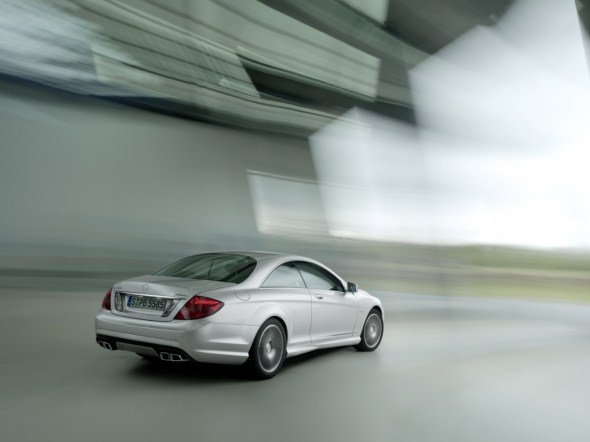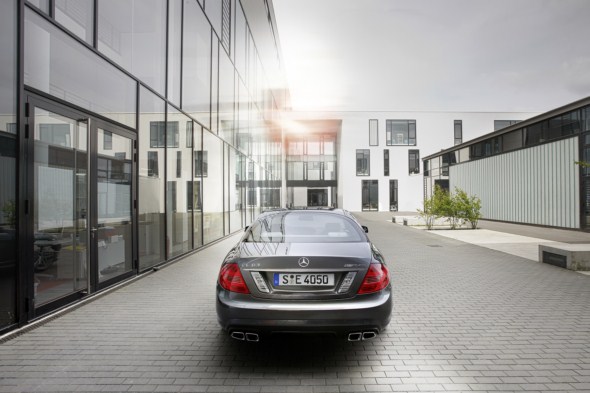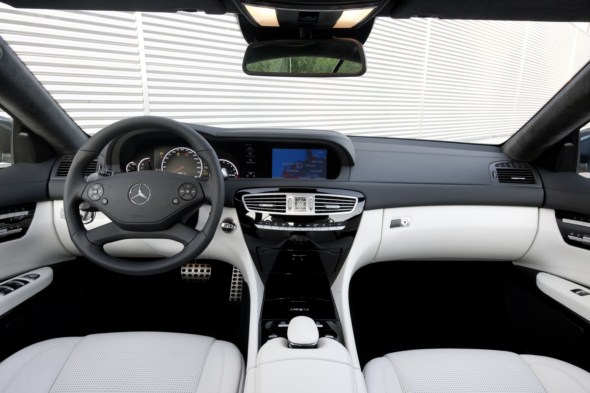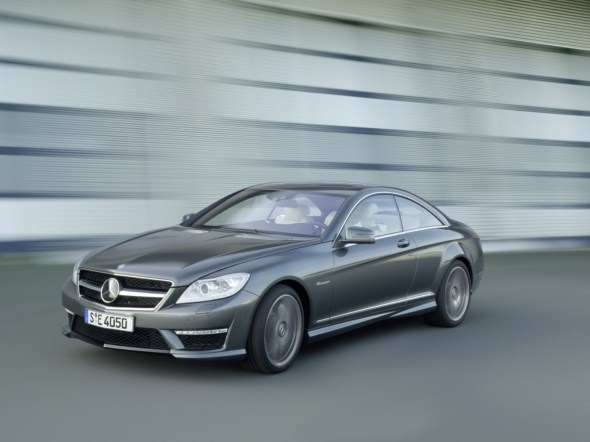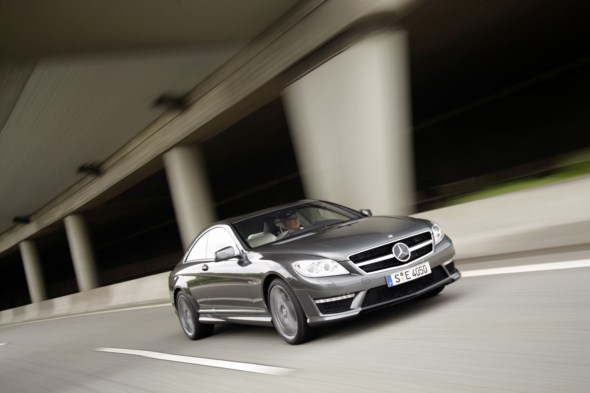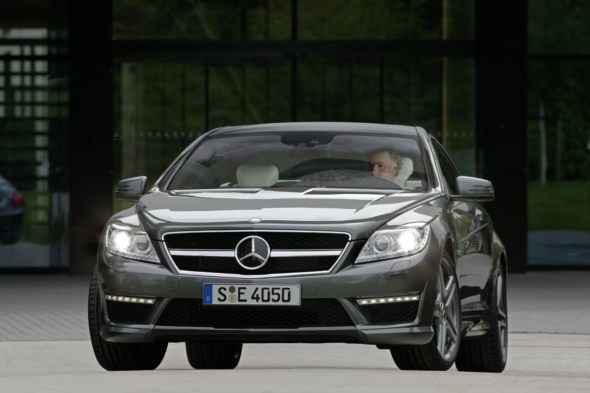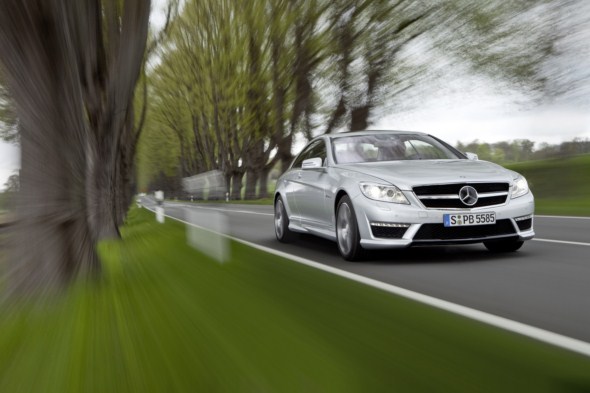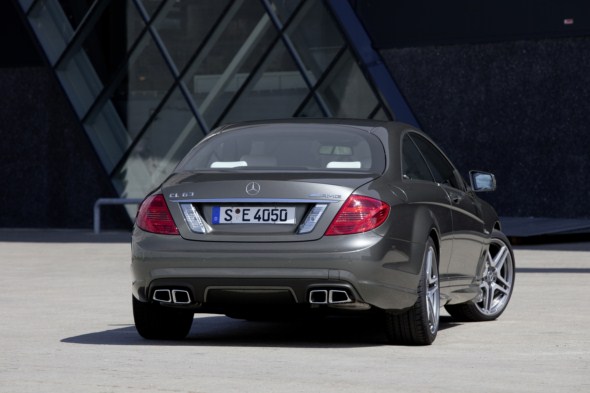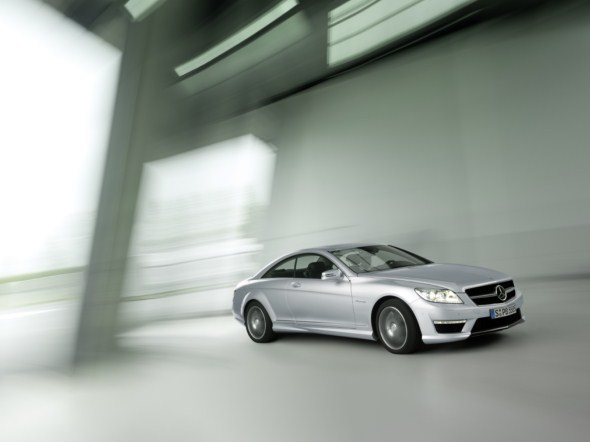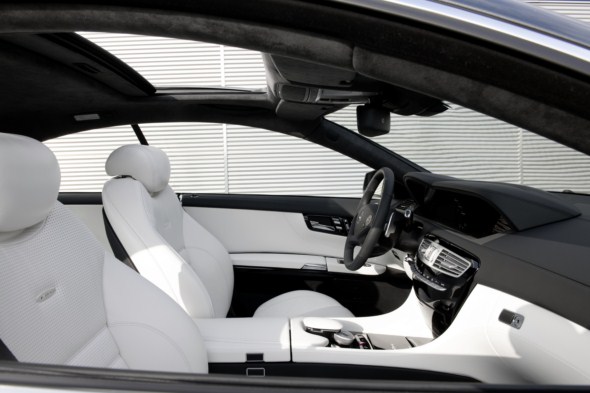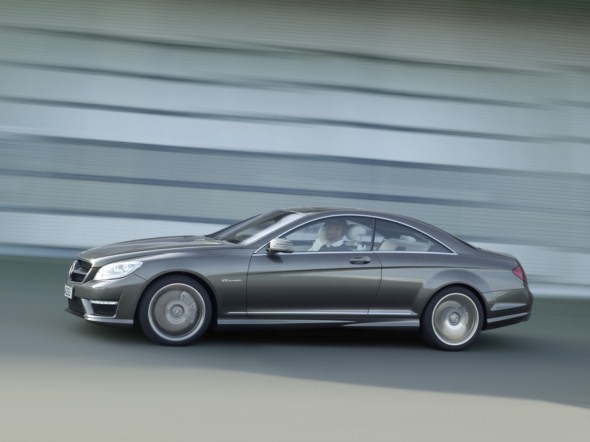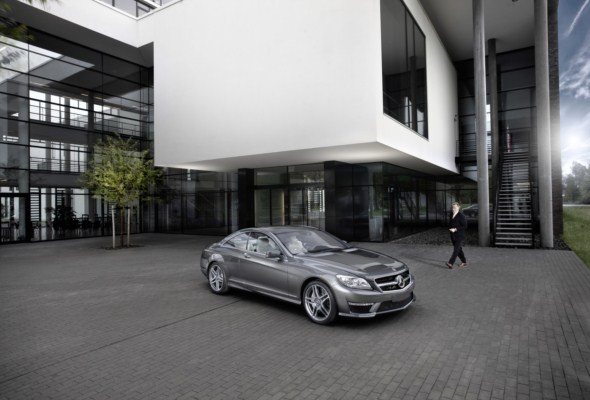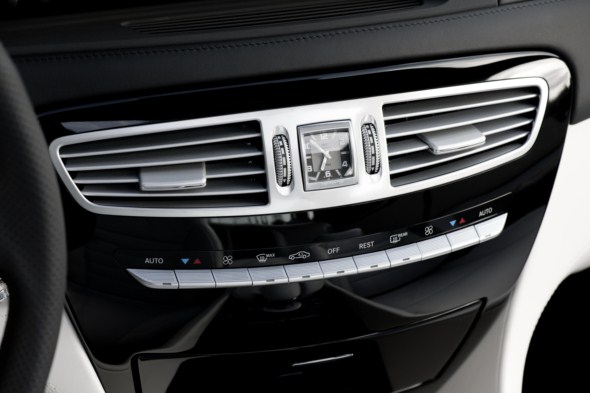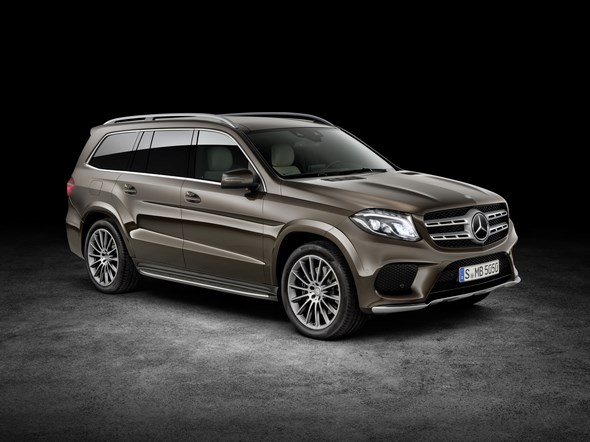Hockenheim – New design and new high-tech drive system: the Mercedes-Benz CL 63 AMG is to feature a new cutting-edge look as well as state-of-the-art technology. The stylish visual modifications will be accompanied by a completely newly developed powertrain. The AMG 5.5-litre V8 biturbo engine with a peak output of up to 420 kW (571 hp) and a torque of up to 900 Nm, in combination with the unique AMG SPEEDSHIFT MCT 7-speed sports transmission, contributes towards a considerable increase in driving dynamics, while at the same time guaranteeing a respectable reduction in consumption and emissions. With a fuel consumption of 10.5 litres per 100 kilometres (NEDC combined), the new high-performance coupé not only undercuts its direct competitors – it is also 27 percent more economical in terms of its fuel consumption than the previous model with naturally aspirated V8 engine.
The new CL 63 AMG marks the start of a new chapter in the “AMG Performance 2015” drive strategy: Mercedes-AMG is continuing this impressive story and is meeting its promise to continuously reduce both the fuel consumption and emissions of new models with the new engine/transmission combination – while reaching new heights with the central AMG brand value of “performance”.
Together with the AMG SPEEDSHIFT MCT 7-speed sports transmission, the new AMG 5.5-litre V8 biturbo engine will play a significant role in the Mercedes-AMG model strategy over the coming year. The new engine/transmission combination marks a further milestone in the successful history of Mercedes-AMG, which began back in 1967.
Designated internally as the M157, the new V8 engine is a prime example of efficiency and features a whole host of impressive technological highlights: for the first time Mercedes-AMG is taking advantage of direct petrol injection with spray-guided combustion and piezo injectors. This technology enables improved fuel economy thanks to higher thermodynamic efficiency, which in turns leads to lower exhaust emissions. AMG has combined the spray-guided combustion with biturbocharging.
Other highlights of the innovative, original eight-cylinder engine from Affalterbach include full aluminium crankcase, four-valve technology with variable intake valve timing, air/water charge air cooling, generator management and also standard start/stop function. Compared with the AMG 6.3-litre naturally aspirated V8 engine with a displacement of 6208 cc, the new AMG 5.5-litre V8 biturbo engine achieves all this with a displacement of 5461 cc.
This high-tech package leads to a high output and torque yield, together with fuel consumption figures that are unrivalled in the competitive lineup. The AMG 5.5‑litre V8 biturbo engine develops a peak output of 400 kW (544 hp) and maximum torque of 800 Nm. In conjunction with the AMG Performance package these figures are increased to 420 kW (571 hp) and 900 Nm. A look at the performance diagrams shows that no other engine in this output class achieves the figures delivered by the new AMG biturbo. The major difference between the two performance classes is an increase in the maximum charge pressure from 1.0 to 1.3 bar. In addition, the engine cover of the CL 63 AMG with the AMG Performance package comes with high-quality carbon-fibre applications.
With an NEDC fuel consumption of 10.5 litres per 100 kilometres, the new CL 63 AMG is 3.9 litres more economical than the previous model powered by the naturally aspirated AMG 6.3-litre V8 – despite an increase in maximum power of 14 kW (19 hp) and 34 kW (46 hp) respectively, and in torque of 170 and 270 Nm. Engine specialists consider this achieved fuel saving of more than 25 percent to be nothing less than a quantum leap. CO2 emissions have likewise been significantly reduced: at 244 grams per kilometre, the figure is 29 percent lower than for the previous model. Both performance variants have identical fuel consumption and CO2 figures.
With figures like these, the new CL 63 AMG is not only considerably better than all its competitors, but also more fuel-efficient than much less powerful cars in this segment.
At the same time the CL 63 AMG delivers superior performance at sports car level: the Coupé accelerates from zero to 100 km/h in 4.5 seconds, and has an electronically limited top speed of 250 km/h. The 100 km/h mark is reached in just 4.4 seconds with the AMG Performance package, with the top speed increased to an electronically limited 300 km/h.
It is not only the unrivalled torque delivery of this turbocharged eight-cylinder that makes the heart beat faster, as the agile responsiveness with no irritating charger delay also leads to an effortlessness and dynamism previously unknown in this output class. All perfectly matched by the characteristic and powerful, sonorous engine note. Moreover, this AMG high-performance engine naturally meets all the requirements with respect to smooth, quiet running and the comfort on long journeys that is to be expected of a Mercedes.
Max. torque 800 Nm at 2000 – 4500 rpm 900 Nm at 2250 – 3750 rpm* at 2500 – 3750 rpm*
Power is transferred by the AMG SPEEDSHIFT MCT 7-speed sports transmission used exclusively by AMG. It combines high emotional appeal with outstanding driving dynamics and a high level of efficiency. A wet start-up clutch replaces a conventional torque converter, and helps to save fuel. The exemplary fuel economy is also in large measure due to the standard stop/start function. This system is active in the transmission’s Controlled Efficiency (“C”) mode, and switches the eight-cylinder engine off when the car comes to a stop. In “C” mode the coupé always starts off in second gear, and the transmission shifts to the next, higher gears at a decidedly early stage. With its high torque at low engine speeds, the V8 engine encourages a smooth, effortless driving style.
The eight-cylinder biturbo engine also features a generator management system: whenever the engine is on the overrun or when braking, kinetic energy is used to charge the battery rather than being wasted as heat in the usual way. In all other operating modes a combination of onboard network and generator management enables the generator to be kept at a low voltage. This reduces the load on the engine and makes for fuel savings of around 0.15 litre per 100 kilometres according to the NEDC standard, and up to 0.2 litre per 100 km in city traffic with its frequent overrun and braking phases.
Like all other AMG engines, the new eight-cylinder biturbo is assembled by hand in the AMG engine shop taken into commission in 2002. Highly-qualified technicians assemble the M157 according to the “one man, one engine” philosophy, maintaining the very strictest quality standards. This painstaking care is attested to by the signature on the characteristic AMG engine plate.
In visual terms, the new CL 63 AMG has an even more athletic, confident appearance. The bonnet, headlamps, radiator grille, bicolour tail lamps and the newly designed AMG bodystyling all add more dynamism. The “V8 Biturbo” lettering on the mudguards points to the new powertrain. Also featuring a new look are the AMG triple-spoke light-alloy wheels, painted in titanium grey and with a high-sheen finish, and fitted with 255/40 and 275/40 R 19 tyres. New in the interior are the AMG sports steering wheel with silver-coloured aluminium shift paddles and specially shaped grip area covered with perforated nappa leather, as well as the “AMG V8 Biturbo” start screen in the AMG instrument cluster. As a new optional extra, SPLITVIEW is also available for the COMAND multimedia system.
With immediate effect, standard equipment on the CL 63 AMG now includes the Direct-Steer system, Torque Vectoring Brake and crosswind stabilisation. With its variable ratio depending on steering angle, the Direct-Steer system helps to ensure a more direct response when cornering, and therefore more responsive handling – in brief: enhanced driving pleasure at the wheel of the Mercedes-AMG CL-Class. Thanks to brief direct application of the brakes on the vehicle’s inner rear wheel when cornering, the Torque Vectoring Brake, meanwhile, helps to ensure that the V8 coupé corners precisely and under control at all times. The Torque Vectoring Brake is an additional feature of the Electronic Stability Program ESP® and not only noticeably improves responsiveness but also active handling safety in critical conditions.
The AMG sports suspension based on Active Body Control (ABC) now also provides crosswind stabilisation as an additional function: thanks to this feature, influences caused by crosswinds are compensated for, or – in the case of strong gusts – reduced to a minimum. ABC compensates against the effect of crosswinds by adjusting the wheel load distribution within milliseconds, using the yaw-rate and lateral acceleration sensors of the ESP®.
Based on the ADAPTIVE BRAKE system with large compound brake discs all round, the AMG high-performance braking system continues to set the benchmark for stopping power, sensitivity and fade resistance.
The unique combination of innovative camera and radar-based driver-assistance systems has been enhanced even further with immediate effect with a view to perfecting the vehicle’s active and passive safety. New optional extras now available for the CL 63 AMG include Active Lane Keeping Assist and Active Blind-Spot Assist. Active Lane Keeping Assist comes into play when the CL 63 AMG unintentionally strays over a solid line on the right or left of a lane or on the outside of a bend. In such cases the Electronic Stability Program ESP® applies the brakes to the wheels on the opposite side of the vehicle to prevent it from unintentionally straying from its lane.
Also new is the Active Blind Spot Assist, which warns the driver by displaying a red warning in the glass of the relevant exterior mirror when it detects that changing lanes would be too dangerous. If the driver ignores the warning signal and a vehicle in an adjacent lane comes too close, the ESP® takes corrective action by applying the brakes to the wheels on the opposite side of the vehicle. Individualisation thanks to AMG Performance Studio and designo New optional extras from the AMG Performance Studio as well as designo enable the vehicle’s individuality to be enhanced even further.
The wide range of designo products includes exclusive paint finishes, leather upholstery, trim elements and steering wheels – as well as the designo Selection, a very special high-end equipment package. The new CL 63 AMG will celebrate its market launch in September 2010. The vehicle will have a sales price of 135,100 euros (excl. VAT)/160,769 euros (incl. 19% VAT). The AMG Performance package costs 7900 euros (excl. VAT)/9401 euros (incl. 19% VAT).
Top-of-the-range CL-Class models from Mercedes-AMG appeal to customers worldwide Exclusivity and dynamism, individuality and high tech: both the CL 63 AMG and the top-of-the-line V12 model, the CL 65 AMG, embody all of these characteristics. Since their market launch in 2007, the CL-Class models from AMG have won the hearts of more than 6,000 customers around the world – making the high-performance Coupés the leaders in their segment. The twelve-cylinder CL 65 AMG model now produces 463 kW (630 hp) and will also be celebrating its market launch in September. The vehicle has a sales price of 191,450 euros (excl. VAT)/227,825.50 euros (incl. 19% VAT).
At a glance: the highlights of the new AMG V8‑biturbo engine and the AMG SPEEDSHIFT MCT 7-speed sports transmission
- Direct petrol injection with piezo-electric injectors and spray-guided combustion
- Twin turbochargers with air/water intercooling
- Sophisticated engine electronics with Controlled Efficiency stop/start function and generator management
- Aluminium crankcase with ventilation holes to reduce friction
- Continuous camshaft adjustment on the intake and exhaust sides
- Demand-controlled engine oil pump
- AMG SPEEDSHIFT MCT 7-speed sports transmission with compact start-up clutch and three drive model
AMG 5.5-litre V8 biturbo engine
Performance, fascination and efficiency in perfect harmony
An increase in maximum performance and torque, a reduction in fuel consumption and exhaust emissions – these qualities are brought together perfectly in the new AMG 5.5-litre biturbo engine. Mercedes-AMG is confronting the challenges of the future, and demonstrating that dynamic performance can be perfectly combined with fuel economy. The result: a maximum output of up to 420 kW (571 hp) and 900 Nm of torque, with an NEDC-combined fuel consumption of only 10.5 litres per 100 kilometres.
The new AMG 5.5-litre biturbo engine combines performance, fascination and efficiency to a previously unknown extent. This is made possible by a unique combination of innovative high-tech systems such as direct petrol injection, twin turbochargers, air/water intercooling and the Controlled Efficiency stop/start function.
Mercedes-AMG is systematically following the trend towards increasing efficiency: with a displacement of 5461 cc it is precisely 747 cc below the 6208 cc of the naturally aspirated AMG 6.3-litre V8 engine. Nonetheless it considerably betters it in terms of output and torque. In the new CL 63 AMG, it develops a peak output of 400 kW (544 hp) and maximum torque of 800 Nm. In conjunction with the AMG Performance Package these figures increase to 420 kW (571 hp) and 900 Nm. The torque curve in particular shows that no other engine in this output class is able to match the figures delivered by the new AMG biturbo unit.
Despite an increase in output of 14 kW (19 hp) and 34 kW (46 hp) respectively, and in torque of 170 and 270 Nm compared to the naturally aspirated V8, which develops 386 kW (525 hp) and 630 Nm, AMG engineers have been able to reduce fuel consumption and CO2 emissions considerably. With an NEDC fuel consumption of only 10.5 litres per 100 kilometres, the new CL 63 AMG betters its predecessor by precisely 4.0 litres. This equates to a fuel saving of 27 percent, which engine specialists consider to be nothing less than a quantum leap.
CO2 emissions have likewise been significantly reduced: at 244 grams per kilometre, the figure is almost 30 percent lower than for the previous model (346 g/km).
The achievement of these efficiency and environmental aims has no negative effects whatsoever on dynamic performance. On the contrary, as the new AMG 5.5-litre V8 biturbo fully lives up to AMG’s brand commitment to “performance”: the CL 63 AMG accelerates from zero to 100 km/h in 4.5 seconds, and has a top speed of 250 km/h (electronically limited). With the AMG Performance package, the high-performance Coupé reaches the 100 km/h mark in 4.4 seconds and reaches a top speed of 300 km/h (electronically limited).
Key data at a glance:
Mercedes-Benz
CL 63 AMG Mercedes-Benz CL 63 AMG with AMG Performance package
Cylinder arrangement V8
Cylinder angle 90°
Valves per cylinder 4
Displacement 5461 cc
Bore x stroke 98.0 x 90.5 mm
Cylinder spacing 106 mm
Compression ratio 10.0:1
Output 400 kW (544 hp) at 5500 rpm
Output per litre 73 kW (100 hp)
Max. torque 800 Nm at 2000 – 4500 rpm
Torque per litre 146 Nm
Maximum engine speed 6500 rpm
Mean pressure 18.5 bar 20.8 bar
Engine weight (dry) 204 kg
Power/weight ratio 0.37 kg/hp 0.36 kg/hp
Fuel consumption
NEDC combined 10.5 l/100 km
CO2 emissions 244 g/km
Acceleration 0 – 100 km/h 4.5 s
Top speed 250 km/h* 300 km/h*
* electronically limited.
Combination of twin turbocharging and direct petrol injection
Mercedes-AMG is presenting an attractive high-tech package with its combination of biturbo charging and direct petrol injection with spray-guided combustion. The innovative injection technology brings decisive advantages with respect to fuel consumption and exhaust emissions, thanks to higher thermodynamic efficiency. Particularly fast and precise piezo-electric injectors spray the fuel into the combustion chambers, ensuring a homogenous fuel/air mixture and highly effective combustion.
An electric low-pressure pump delivers the fuel from the tank to a high-pressure pump in the boot with a pressure of six bar. The fuel pressure in the high-pressure rail is controlled between 100 and 200 bar on a fully variable and demand-related basis.
Two turbochargers and efficient air/water intercooling
Two turbochargers located next to the cylinder banks supply the eight cylinders with fresh air. At their maximum speed of 185,000 rpm under full load, the two turbochargers force 1750 kg into the combustion chambers per hour. The maximum charge pressure is 1.0 bar, and 1.3 bar with the AMG Performance package. Thanks to their specific, compact construction – the turbine housings are welded to the exhaust manifold – there are significant space advantages and the catalytic converters also heat up more rapidly.
The new AMG V8 is the first turbocharged engine to dispense with the usual blow-off valve. This neat solution enabled the compressor housing to be made extremely compact. To ensure agile responsiveness with no time lag, all the air ducts in the intake tract are as short as possible. The wastegate valve, which reduces the pressure in the exhaust system during negative load changes, is vacuum-controlled via an electropneumatic converter. This allows dethrottling under partial loads, which in turn lowers the fuel consumption.
As was already the case in the AMG 6.0-litre V12 biturbo engine, the new eight-cylinder direct-injection unit uses particularly efficient air/water intercooling. The low-temperature cooler with its water circulation is space-savingly accommodated within the V of the cylinder banks.
It effectively cools down the intake air compressed by the turbochargers before it enters the combustion chambers, and maintains a constantly low intake temperature under full load. A large radiator at the car’s front end ensures defined cooling of the water circulating in the low-temperature circuit. This guarantees a high output and torque yield in all ambient temperatures and operating conditions.
Extremely short charge-air ducting makes for outstanding responsiveness. The stainless steel pressure pipes for the fresh and charge air are produced by the hydroforming process, have a wall thickness of only 0.8 millimetres and are designed for particularly low pressure loss.
Aluminium crankcase with Silitec cylinder liners The crankcase of the new AMG 5.5-litre V8 biturbo engine is of diecast aluminium. The low (dry) engine weight of just 204 kilograms is the result of uncompromising lightweight construction methods, and leads to the car’s very balanced weight distribution. The bearing cover for the main crankshaft bearings is of grey cast iron, and is bolted to the crankcase for high rigidity. Cast-in Silitec cylinder liners ensure that the eight pistons operate with low friction.
Drilled pulsation holes in the crankcase lead to a higher output and fuel savings under partial load: above the bearing blocks there are longitudinally drilled holes which connect adjacent crankcase cavities. Normally the upward and downward movement of the pistons causes air to be forced into and extracted from the sump, which leads to increased internal friction losses and therefore a reduction in output. The pulsation holes prevent this by ensuring effective pressure compensation between the cavities.
The forged crankshaft of high-grade 38MnS6BY steel alloy rotates in five main bearings, has eight counterweights and has been optimised with respect to torsional rigidity, inertia, low rotating masses and a long operating life. A two-mass viscous damper mounted at the front reliably eliminates vibrations. Each connecting rod journal on the crankshaft carries two forged, cracked connecting rods. In the interests of low mechanical friction and high wear resistance, the lightweight pistons have a metallic contact surface. Pressure-controlled oil-spray nozzles in the crankcase ensure that the highly stressed piston crowns are efficiently cooled.
Four-valve technology with variable camshaft adjustment Perfect charging of the combustion chambers is ensured by large intake and exhaust valves, of which there are four per cylinder. The exhaust valves, which are subject to high thermal loads, are hollow and sodium-cooled. Four overhead camshafts operate the 32 valves via low-maintenance, low-friction cam followers. The infinitely variable camshaft adjustment within a range of 40 degrees on the intake and exhaust sides depends on the engine load and engine speed, leading to outstanding output and torque values. This also results in consistent idling at a low speed.
Depending on the engine speed, valve overlap can be varied for the best possible fuel/air supply to the combustion chambers and efficient removal of the exhaust gases. The variable camshaft adjustment is carried out electromagnetically via four pivoting actuators, and is controlled by the engine control unit. The camshafts are driven by three high-performance silent chains, which have considerable advantages in noise comfort compared to cylinder roller chains.
Efficient oil supply and water cooling
Efficient oil delivery under all load and operating conditions is ensured by an oil pump with an electrically controlled compression stage. The oil pressure can be varied between two and four bar, which has advantages in terms of friction and fuel consumption. An extraction stage integrated into the oil pump for the two turbochargers prevents oil from being entrained into the charge air and exhaust gases, thereby helping to reduce emissions even further. Both the sump and the extraction point have been optimised for maximum lateral acceleration and efficient lubrication. The oil capacity is 10.5 litres.
The combined water/oil cooling system is a particularly innovative solution: initially the engine oil only flows through the oil/water heat exchanger. If the cooling performance of the very compact cooler is insufficient, the flow is directed through the external engine oil/air cooler by an oil thermostat. The advantage of this system is that the engine oil warms up more rapidly, as the engine coolant warms up faster and the oil is later cooled by the coolant. A selectable water thermostat ensures rapid warming of the coolant when starting the engine and driving off.
The engine coolant is cooled using the particularly effective crossflow principle. There is a transverse flow of coolant through both the crankcase and the cylinder heads. Additional cooling slots in the cylinder head ensure more efficient cooling of the combustion chambers, which has advantages during combustion: it enables earlier ignition timings to be chosen without incurring the risk of knocking.
Highly efficient engine electronics for every function
All the engine functions are executed and controlled by a particularly efficient Bosch MED 17.7.3. control unit. This state-of-the-art engine computer not only controls the direct petrol injection, charge pressure, camshaft adjustment and variable oil supply, but also communicates with all the other onboard control units. The microprocessor has more than 30,000 different parameters and functions stored in its memory, and is able to perform up to 260 million individual operations per second. To reduce the load on the engine control unit, the eight individual ignition coils have an integral electronic module known as an ignition amplifier at each cylinder. These ensure a strong ignition spark at all engine speeds and under all load conditions. Eight high-voltage powerstages are responsible for highly precise fuel distribution to the piezo-electric injectors.
Effective emissions technology with new catalytic converter boxes Low exhaust emissions, compliance with country-specific standards and a characteristic AMG engine sound – the requirements for the exhaust system of the new AMG 5.5-litre V8 biturbo engine were manifold and complex. The CL 63 AMG complies with all the current EU-5 emission standards, as well as meeting all the requirements of the US market (LEV-II standard, On-Board Diagnosis II and lambda sensor diagnosis).
The turbochargers are welded to the exhaust manifolds, while air gap-insulated manifolds with a wall thickness of only 1.0 millimetre ensure a rapid catalytic converter response. For efficiency and to save space, this concept has a tandem catalytic converter housing on each side of the vehicle: adjacent to the firewall, two thin-walled ceramic substrates are grouped into each housing.
This solution makes the previous, additional underbody catalytic converters unnecessary. The two ceramic substrates differ to ensure rapid and efficient emissions control: the front one is coated with palladium, while the rear one has a bimetal coating of palladium and rhodium. One lambda sensor per row of cylinders is located in front of each catalytic converter housing, and there is a lambda diagnostic sensor between each of the two thin-walled substrates.
The lambda sensors are necessary for demand-related lambda control. In all operating conditions, the constituents of the intake mixture can be precisely controlled to avoid damaging the catalytic converters. This also benefits the fuel consumption under full load, as the mixture can be leaner than in engines without this control system. Twin-pipe AMG sports exhaust system for a characteristic sound signature The twin-pipe AMG sports exhaust system has a pipe cross-section of 70 millimetres from the manifolds to the rear silencers.
When designing the sound, the aim was to create a perfect synthesis of perceived dynamism and the comfort on long journeys that is the hallmark of a Mercedes. The goal of the developers was to achieve an emotional experience when accelerating and double-declutching, but unobtrusiveness at constant speeds. Unpleasant frequencies or droning noises were effectively eliminated during a series of painstaking tests. The sports exhaust system emits a sonorous eight-cylinder sound that is typical of AMG, while the striking chrome twin tailpipes feature a new design.
AMG sports suspension and high-performance braking system
Perfect blend of driving dynamics, ride comfort and active safety The Direct-Steer system, Torque Vectoring Brake and crosswind stabilisation are the three new systems available as standard on the CL 63 AMG with
immediate effect. In combination with the AMG sports suspension and AMG high-performance braking system, these unique high-tech systems provide the highest level of driving dynamics, ride comfort and active safety.
Less steering effort, more agile handling with the same outstanding straight-line stability – the Direct-Steer system in a nutshell, which is now fitted as standard to the CL 63 AMG. A key feature of the Direct-Steer system – which is well-known in the S-Class – is the variable-ratio steering rack that operates using purely mechanical means. While the power steering around the central position utilises an indirect ratio to promote excellent straight-line stability, this alters from a steering angle of around five degrees: really small steering angles are all it takes to perform precise cornering, noticeably improving handling on winding country roads. The steering angle requirements have also been modified, enabling the driver to steer the AMG Coupé far more easily, particularly on urban roads.
Compared with a steering system with a constant ratio, the number of revolutions from lock to lock is reduced by around 25 percent with the Direct-Steer system. Another advantage of the purely mechanical Direct-Steer system is the absence of any elaborate actuators and complex sensors – with associated benefits in terms of weight, installation space and susceptibility to faults. The constant steering response is also advantageous compared with other variable steering systems that sometimes require the driver to adapt quickly to what are fast changing situations on the road.
The Direct-Steer system is based on the familiar speed-sensitive power steering system which reduces the power assistance as the road speed increases. Easy manoeuvrability on urban roads where large steering angles and thus a great deal of power assistance is required, is coupled with reduced support at high speeds, say on the motorway – all of which improves straight-line stability and handling safety.
Torque Vectoring Brake optimises driving dynamics and handling safety A further improvement in driving dynamics as well as active handling safety comes courtesy of the Torque Vectoring Brake. If the Electronic Stability Program ESP® detects the onset of understeer, short one-sided braking intervention on the vehicle’s inside rear wheel generates a specific yawing moment around the vehicle’s vertical axis within a fraction of a second. Consequently, the AMG CL-Class handles precisely and remains under control at all times as well as also bolstering active handling safety by reducing the tendency to understeer.
Automatic crosswind stabilisation as standard
The AMG sports suspension based on Active Body Control (ABC) also comes as standard with automatic crosswind stabilisation. The ABC control electronics vary the wheel load distribution so that the effect of crosswinds is virtually compensated for or reduced to a minimum.
If the CL 63 AMG is affected by a crosswind, the ABC control unit utilises the yaw-rate, lateral acceleration, steering angle and speed sensors of the Electronic Stability Program ESP® to trigger diagonal wheel load distribution instantly – for instance on the left front and right rear wheel. The associated steering effect reduces the effect of the crosswind. Crosswind stabilisation is activated at speeds above 80 km/h while travelling in a straight line or on slight bends. The function is deactivated if the driver himself makes heavy, brusque steering corrections.
The AMG sports suspension all but entirely eliminates the body movements that occur when moving off, cornering and braking. Bends are negotiated with far less roll; the body roll caused by fast evasive manoeuvring is effectively suppressed. Other notable features of Active Body Control are the variable roll moment distribution between the front and rear axles, which the system carries out automatically according to the speed. The computer uses various acceleration sensors to obtain information on the current driving situation and compares this data with those from the pressure sensors in the spring struts and the level sensors on the control arms. The system then computes the control signals that the servo-hydraulic valves at the front and rear axle transform into precisely metered flows of oil.
Briefly pressing the Sport button next to the AMG instrument cluster changes the characteristics of the AMG sports suspension: the roll angle through fast corners is reduced further, the shock absorbers and springs also respond firmer to promote agility. At speeds of between 65 and 100 km/h, ABC automatically lowers the body by as much as 15 millimetres to reduce wind resistance. If more ground clearance is needed when driving on poor road surfaces, the level of the vehicle can be raised by 40 millimetres at a speed up to 30 km/h by simply pressing a button.
Thanks to so-called loading adjustment, the active suspension control also takes the current vehicle weight into account as part of its calculations. As such the CL 63 AMG is able to achieve identical levels of driving dynamics when in a laden condition too. AMG high-performance compound braking system based on ADAPTIVE BRAKE Based on the ADAPTIVE BRAKE system, the AMG high-performance braking system continues to set the benchmark for stopping power, sensitivity and fade resistance.
The front axle features a double floating brake calliper; this technology combines the advantages of a sliding-calliper disc brake – reduced heat transfer to the brake fluid and clear advantages in terms of comfort thanks to the brake lining guide mechanism – with the efficiency of an extra large fixed calliper brake. At the rear, braking is handled by a large sliding frame-type
calliper. Internally ventilated, perforated composite brake discs at the front and rear with a diameter of 390 and 365 millimetres respectively ensure the shortest stopping distances, remarkable resistance to fading and outstanding sensitivity.
The hydraulic dual-circuit braking system is controlled electronically, permitting the inclusion of numerous driver assistance functions that improve safety and comfort – such as “priming” the braking system in critical situations: if the driver suddenly switches from the accelerator to the brake pedal before emergency braking, ADAPTIVE BRAKE increases the pressure in the brake lines and applies the pads to the brake discs, so that they can grip instantly with full force when the brake pedal is pressed. In wet weather, the system injects regular, short brake impulses to ensure that the film of water on the brake discs is wiped off and the brakes can work as effectively as possible.
This automatic brake-drying function is always activated when the windscreen wipers have been in operation for a certain time; the driver does not notice the finely metered braking impulses.
After the CL 63 AMG has been braked to a standstill, briefly pressing the brake pedal a little further is all that is required to activate the HOLD function. The coupé is then held by the brakes, even if the driver’s foot comes off the brake pedal.
In this way ADAPTIVE BRAKE prevents the car from rolling forward inadvertently when stopped at traffic lights or stuck in stop-and-go traffic, and from rolling back when facing a slope. The HOLD function is deactivated automatically when the car moves off. Attractive light-alloy wheels featuring a new AMG triple-spoke design AMG light-alloy wheels featuring a new triple-spoke design and painted in titanium grey with a high-sheen finish provide the contact with the road. 255/40 ZR 19 tyres are fitted on 8.5 x 19 wheels at the front, while 275/40 R 19 tyres are combined with 9.5 x 19 wheels at the rear. Exclusive optional extras from the AMG Performance Studio include AMG double-spoke forged wheels, painted in black and polished. The dimensions are: 255/35 R 20 tyres on 8.5 x 20 wheels (front) and 275/30 R 20 tyres on 9.5 x 20 wheels (rear).
Power transmission with stop/start function
Maximum driving pleasure, reduced fuel consumption
The new AMG SPEEDSHIFT MCT 7-speed sports transmission guarantees an exceptional emotional experience and sheer driving pleasure. Equipped with seven gears, three driving modes and a double-declutch function, the power transmission of the new CL 63 AMG represents sheer emotive appeal.
At the same time it makes a considerable contribution to fuel economy – and specifically in combination with the Controlled Efficiency drive mode with stop/start function and generator management included as standard features. Accordingly the AMG MCT transmission impresses with a combination of unique functions which no other manufacturer offers.
The AMG SPEEDSHIFT MCT 7-speed sports transmission is an innovative power transfer system that made its debut in the high-performance SL 63 AMG Roadster in 2008. It combines the sporty, direct and agile feedback of a manual transmission with the maximum convenience of an automatic transmission. Featuring seven gears, three driving modes and a double-declutch function, the 7-speed sports transmission offers superb versatility. MCT stands for Multi-Clutch Technology and indicates that only clutch elements are employed to perform gearshifts.
A compact wet start-up clutch, which runs in an oil bath, replaces the conventional torque converter. Thanks to its low rotational inertia, the transmission responds instantaneously and dynamically without the losses typical of a torque converter transmission – thereby helping to save fuel. The AMG sports transmission also impresses with its low weight of just 80 kilograms, which has been made possible through the use of lightweight magnesium for the transmission housing.
Vibrations are effectively eliminated by a new, two-stage torsion damper, with resulting benefits in perceived passenger comfort. Consumption-optimised Controlled Efficiency (“C”) drive mode During its development and adaptation to the AMG 5.5-litre V8 biturbo engine, the AMG engineers paid special attention to the new driving mode Controlled Efficiency (“C”). The emphasis was on delivering minimum engine speed coupled with a reduced number of gearshifts in all driving situations.
When moving off in “C”, the MCT transmission always selects second gear and shifts decidedly early to the next higher gears if the driving style permits. At 60 km/h for instance, sixth gear will already be engaged – not only improving fuel consumption but also noise levels. Thanks to its powerful, readily available torque even at low engine speeds, the AMG V8 biturbo unit is absolutely ideal for this style of driving. Controlled Efficiency also means convenient gearshifts and a “soft” accelerator response set-up for outstandingly smooth power transfer.
Controlled Efficiency stop/start function as a new feature
The Controlled Efficiency stop/start function is also being used in an AMG model for the first time. This system is standard equipment in the CL 63 AMG, and permanently active in the fuel economy driving mode “C”. Once the driver comes to a halt e.g. at a red traffic light, the V8 engine is automatically switched off. Once the brake pedal is released or the accelerator is depressed, the engine is immediately restarted and the car is able to move off quickly. Intelligent technology guarantees a comfortable and immediate starting procedure: a crankshaft sensor which recognises the direction of rotation registers the resting position of all eight pistons. For an automatic engine start, the cylinder with the most favourable piston position receives an injection of fuel into its combustion chamber. The precise piezo-electric injectors greatly assist this process, as they make particularly fast starts possible.
The engine management ensures that the engine is only switched off if certain preconditions are met. The starter battery must have sufficient charge, for example, and the engine must be at the necessary operating temperature for efficient emissions control. The same applies to the interior temperature selected by the driver: if this has not yet been reached, the engine is not switched off when the car comes to a stop. The onboard network management system makes sure that active audio, telephone or video functions are not interrupted by the stop/start function.
A green “ECO” symbol in the AMG main menu shows the driver that the Controlled Efficiency stop/start function is active. Should one of the above criteria be preventing activation of the system, this is shown in the central display by the message “Stop/start inactive” and a yellow “ECO” symbol. In the two more performance-oriented driving modes “S” (Sport) and “M” (Manual), the start/stop function is always deactivated. If required, the driver can also switch it off while in “C” mode as well. The eight-cylinder biturbo engine also features a new generator management system: whenever the engine is on the overrun or when braking, kinetic energy is used to charge the battery rather than being wasted as heat in the usual way.
In all other operating modes a combination of onboard network and generator management enables the generator to be kept at a low voltage. This reduces the load on the engine and makes for fuel savings of around 0.15 litres per 100 kilometres according to the NEDC standard, and up to 0.2 litre per 100 km in city traffic with its frequent overrun and braking phases. Drive modes “S” and “M” for even more driving pleasure and dynamism
The engine and transmission come across as much more agile in the “S” (Sport) mode. Accelerator pedal movements trigger a more direct traction response, making the downshifts more spontaneous.
The engine speed is allowed to reach a higher level in each gear, while the gearshifts are around 25 percent faster than in “C”. In the manual shift mode “M”, gearshifts at full throttle take just 100 milliseconds, a reduction of 50 percent compared to “C”. In “S” and “M” modes, the engine management system partially suppresses the cylinders: interrupting ignition and injection under full load leads to even faster gearshifts than before. The highly emotional vocals are an appealing side effect of this lightning-fast process.
Ultra-fast, spontaneous multiple downshifts are another forte of the AMG SPEEDSHIFT MCT 7-speed sports transmission. For instance, kickdown allows gearshifts straight from seventh down to fourth gear, or from fifth to second. In the “S” and “M” driving modes the automatic double-declutching function is active. Every manual or automatic downshift is accompanied by precisely metered double-declutching – incrementally from “S” to “M”. And this not only adds to the driver’s emotional experience: the load-free downshift minimises load-change reactions, which pays particular dividends when braking into bends – and also enhances safety in the wet or on ice.
No automatic downshifts in manual “M” mode In manual “M” mode the driver also benefits from the high torque of the V8 biturbo engine, as there is no automatic downshift under full load and kickdown; the transmission remains steadfastly in the selected gear. Moreover, the AMG MCT 7-speed sports transmission does not perform an automatic upshift in manual mode when the rev limit is reached.
In “M” mode the AMG instrument cluster
displays the current gear and alerts the driver to the need for an upshift just before the needle reaches the red zone. This means that a particularly sporty driver can use the superior performance potential to its fullest extent. When approaching the lower rev limit, e.g. when braking the vehicle, there is an automatic downshift to the next lower gear.
The gears can be shifted using the steering wheel shift paddles – whatever the driving mode. The electronic key for selection of the three driving models is located to the left of the COMAND controller. The powerful electronic
transmission control unit with its integrated 80 MHz processor guarantees immediate downshifts – for example when approaching traffic lights or if the driver requires fast acceleration when overtaking. Active and passive safety.
A unique combination of driver-assistance systems
The large-scale Mercedes coupé has always been synonymous with the ultimate in active and passive safety systems. A significant part of such systems is also made up of the unique combination of trend-setting camera and radar-based driver assistance systems. The latest innovations are called Active Lane Keeping Assist and Active Blind Spot Assist, both of which are available as optional extras.
The combination of state-of-the-art assistance and protection systems turn the AMG CL-Class into an “intelligent” partner which is able to “see”, “feel”, to respond “instinctively” to detected dangers and to act “on its own initiative” in order to avoid accidents or to reduce the severity of accidents. The vehicle makes use of cameras which look far ahead, observe the conditions around the vehicle, and are able to interpret typical critical situations.
Like the Mercedes-Benz S-Class, the CL 63 AMG is now also available with the new Active Lane Keeping Assist. When the driver unintentionally drives over a solid line to the right or left of a lane or on the outside of a bend, the Active Lane Keeping Assist intervenes and prevents the vehicle from unintentionally leaving the lane. In such cases it applies the brakes to the wheels on the opposite side of the vehicle, using the sensor system of the Electronic Stability Program ESP®.
Similarly, when the new Active Blind Spot Assist system detects that changing lanes would be dangerous, it the driver by displaying a red warning in the glass of the relevant exterior mirror. If the driver ignores the warning signal and a vehicle in an adjacent lane comes too close, the ESP® takes corrective action by applying the brakes to the wheels on the opposite side of the vehicle.
Night View Assist Plus and Speed Limit Assist
The enhanced Night View Assist Plus with infrared camera (optional extra) is now equipped with special pedestrian detection: as soon as the system detects pedestrians on the road ahead, they are highlighted on the display to make them more readily noticeable for the driver. The images supplied by the windscreen camera are also used by the Speed Limit Assist, which is available as an optional extra. It recognises speed limit signs in passing and shows the relevant speed limit in the central display.
Adaptive Highbeam Assist is now also included as part of the standard equipment specifications. The camera-based system can detect vehicles with their lights on which are travelling towards or ahead of the car in which the system is fitted and controls the headlamps such as to ensure the largest possible range without dazzling other drivers. Drowsiness detection on the basis of more than 70 parameters Thanks to innovative technology the CL-Class has a very sensitive antenna for the attention level of its driver, and can warn him in time when he becomes drowsy.
The ATTENTION ASSIST drowsiness detection system, well-known from the S-Class, continuously monitors more than 70 different parameters. Once the evaluation electronics recognise the steering behaviour pattern that typically indicates the onset of drowsiness on the basis of information from the highly sensitive steering angle sensor, a warning signal is sounded and “ATTENTION ASSIST. Break!” appears in the instrument cluster. ATTENTION ASSIST is fitted as standard.
“Electronic crumple zone” for maximum occupant protection
Mercedes-Benz has also improved the long and medium-range radar used by the optional Brake Assist BAS PLUS and DISTRONIC PLUS proximity control. Mercedes-Benz also offers another radar-based system for the CL-Class in the form of PRE-SAFE® Brake.
If the driver is distracted and fails to recognise the immediate danger of a rear-end collision, or the warning signals of an assistance system, this system can intervene and brake the vehicle independently. The CL-Class makes use of the latest development stage of this safety system: if the driver fails to react even after automatic partial braking action, the PRE-SAFE® Brake activates the maximum braking pressure around 0.6 seconds before what is now recognised as an unavoidable accident – an emergency braking action that can significantly mitigate the severity of the impact. The PRE-SAFE® Brake therefore acts as something like an “electronic crumple zone”.
Design and equipment
A new look for even more dynamism
More status, more sportiness, more elegance – these are the characteristics now portrayed by the design of the new CL 63 AMG. Thanks to specific modifications to the front and rear, as well as AMG light-alloy wheels, the high-performance coupé now looks even more confident and athletic than ever. The tastefully designed interior and the comprehensive range of standard equipment help to guarantee an air of exquisite sophistication. New optional extras such as SPLITVIEW for the COMAND multimedia system also ensure maximum comfort for the vehicle occupants.
The front section of the CL 63 AMG boasts numerous new design features which give the coupé an even more powerful appearance than ever. The new, arrow-shaped bonnet with its exciting ridged design is the perfect match for powerfully-shaped headlamps, which now come equipped with the Intelligent Light System (ILS) as standard. Other features include bi-xenon headlamps with active light function, Adaptive Highbeam Assist and also AMG-specific LED daytime driving lights in the front apron. A more dynamic appearance is also provided courtesy of the more steeply swept-back radiator grille with larger, chrome-trimmed cooling-air intake. The central Mercedes star is flanked by a distinctive horizontal grille slat. The new front apron, which is part of the AMG bodystyling, has a three-dimensional drawn-out design as well as a lower cross strut painted black and with a high-gloss finish.
The rear too has been updated: new taillamps with one-piece red-coloured cover plates and new reversing headlamps next to the licence plate recess on the boot lid match the new AMG rear apron. In addition to the diffuser insert, which is in the same colour as the vehicle body, another visual highlight comes in the form of the newly designed chrome twin tailpipes of the AMG sports exhaust system.
Unmistakable AMG triple-spoke light-alloy wheels
Viewed from the side, the CL 63 AMG stands out thanks to the “V8 BITURBO” lettering on the mudguards. Additional highlights include the newly designed AMG light-alloy wheels, with their unmistakable triple-spoke design, painted in titanium grey and with a high-sheen finish. They are fitted with 255/40 R 19 tyres at the front, and 275/40 R 19 tyres at the rear.
Sporty interior with exclusive appointment details
The tastefully designed interior of the CL 63 AMG boasts an exciting combination of exclusive appointment details. The AMG instrument cluster, for example, now has a new look: after opening the driver’s door, the words “AMG V8 BITURBO” are displayed on the screen – a clear invitation to start the new eight-cylinder engine. Also new is the AMG sports steering wheel with silver-coloured aluminium shift paddles, specially shaped grip area and perforated nappa leather around the steering wheel spokes.
The multifunction buttons on the left and right enable the driver to select numerous settings and call up information, for example in the AMG main menu: the activated transmission mode is displayed in the middle of the instrument cluster – the currently engaged gear and recommended upshifts are also shown in “M” mode. A new feature is the Controlled Efficiency stop/start function: a green “ECO” symbol in the AMG main menu tells the driver that it is enabled, while a yellow “ECO” symbol indicates that the “start/stop function is disabled”.
The AMG main menu also provides the driver with information about the temperature of the engine oil and coolant. With the RACETIMER, the driver can calculate lap times – when on a private racing circuit, for instance. The RACETIMER records the time for the fastest lap, the average and maximum speeds and the lap distance. The AMG instrument cluster in the CL 63 AMG comes with a 320 km/h speedometer scale. One of the most eye-catching features in the interior is the exclusive analogue clock with its “IWC Ingenieur” design in the centre console.
AMG sports seats with PASSION leather upholstery
Standard equipment includes 12-way electrically adjustable AMG sports seats with Memory package, Seat Comfort package with front active multicontour seats including massage and dynamic handling function, with seat heating and ventilation, PRE-SAFE® positioning function and NECK-PRO luxury head restraints.
The PASSION leather upholstery boasts sporty, AMG-specific seat fluting and also high-quality AMG badges in the backrests.
The exclusive interior appointments are available in three colour combinations: black/black, cashmere beige/savanna beige and alpaca grey/basalt grey. In conjunction with the three wood trims high-gloss black ash, high-gloss dark brown burr walnut, and high-gloss light brown burr walnut, a wide variety of options are available to meet every individual taste.
The extensive standard specification of the CL 63 AMG includes (selection):
- Adaptive brake lights
- AMG door entry sills
- AMG floor mats
- AMG sports pedal cluster
- ATTENTION ASSIST
- COMAND
- ISOFIX and automatic child seat recognition
- Parking guidance
- PRE-SAFE®
- Tilting/sliding glass sunroof, electric, with PRE-SAFE® closure function
The new SPLITVIEW technology for COMAND and/or COMAND APS is also available as an optional extra. This innovative display concept allows the driver and front passenger to view different content simultaneously on the same screen. While the driver uses the map-based navigation system, for example, the front passenger can be watching the latest film on DVD using headphones, without disturbing the driver.
The wide range of optional extras also includes (selection):
- Ambient lighting, adjustable in three colours
- Brake Assist BAS PLUS
- DAB – digital radio
- DISTRONIC PLUS
- Driving Assistance Plus package
- KEYLESS-GO
- Refrigerated compartment in rear seat backrest
- Exclusive PASSION leather package
- Night View Assist Plus
- Navigation package incl. COMAND APS
- PRE-SAFE® Brake
- Reversing camera
- TV tuner
Individualisation
AMG Performance Studio and designo – tailor-made exclusivity and sportiness
Further touches of dynamism and exclusivity can be achieved with the optional extras available from the AMG Performance Studio and designo. Customers with specific tastes will find a unique series of appointment
details here to reflect their own personal style.
The optional extras from the AMG Performance Studio as well as from designo provide for the proverbial tailor-made individuality. With these items, customers have the option of giving their CL 63 AMG a highly personalised and exceptional finishing touch. Opened in Affalterbach in 2006, the AMG Performance Studio stocks both technical and visual enhancements for the top-of-the-range coupé.
The appointments at a glance:
- AMG Performance package: increase in power of 20 kW (27 hp) and 100 Nm, carbon fibre AMG engine cover.
- AMG double-spoke forged wheels, painted in black with a mirror finish and fitted with 255/35 R 20 (front) and 275/30 R 20 (rear) tyres.
- AMG double-spoke forged wheels, painted in titanium grey with a mirror finish and fitted with 255/35 R 20 (front) and 275/30 R 20 (rear) tyres.
- AMG Exterior Carbon package: cross strut on the front apron, exterior mirror housings and rear apron insert in carbon fibre
- AMG Performance steering wheel in nappa leather with Alcantara® inserts in the grip areas.
- AMG carbon-fibre trim elements in the interior.
Exclusive designo line-up with designo Selection
The entire designo range is available to provide further individualisation
options – an exclusive selection of different paint finishes, leather upholstery, trim elements and steering wheels: ten different designo paint finishes can be combined with ten designo aniline leather appointments options – with the result that there are practically unlimited possibilities for customers to turn their personal preferences into reality.
Particular highlights come courtesy of the matt paint finishes designo magno cashmere white and designo magno platinum, for example.
The designo aniline leather colours deep white, deep black and light brown provide customers with even more individualisation options. When it comes to designo the customer can choose from six different exclusive trim elements: natural maple grain and matt natural oak grain as well as two high-gloss piano lacquer trim elements in black or champagne white. The unique designo stone trim elements made from genuine granite are available in two versions for the CL-Class: Labrador blue pearl and Star Galaxy. To highlight the exclusivity of the designo trim elements, customers can adorn the cupholder cover with handmade designo lettering in 925 sterling silver.
Mercedes-Benz is offering a high-end equipment package for the CL 63 AMG in the shape of the designo Selection. Customers are able to configure their CL-Class according to their personal preferences and taste from all the designo paint finishes, designo leather colours and designo trim elements. Other components of the package include a black roof liner in nappa leather with special fluting, a matching designo wood/leather steering wheel and designo lettering in solid 18-carat gold – produced exclusively for the designo Selection.
